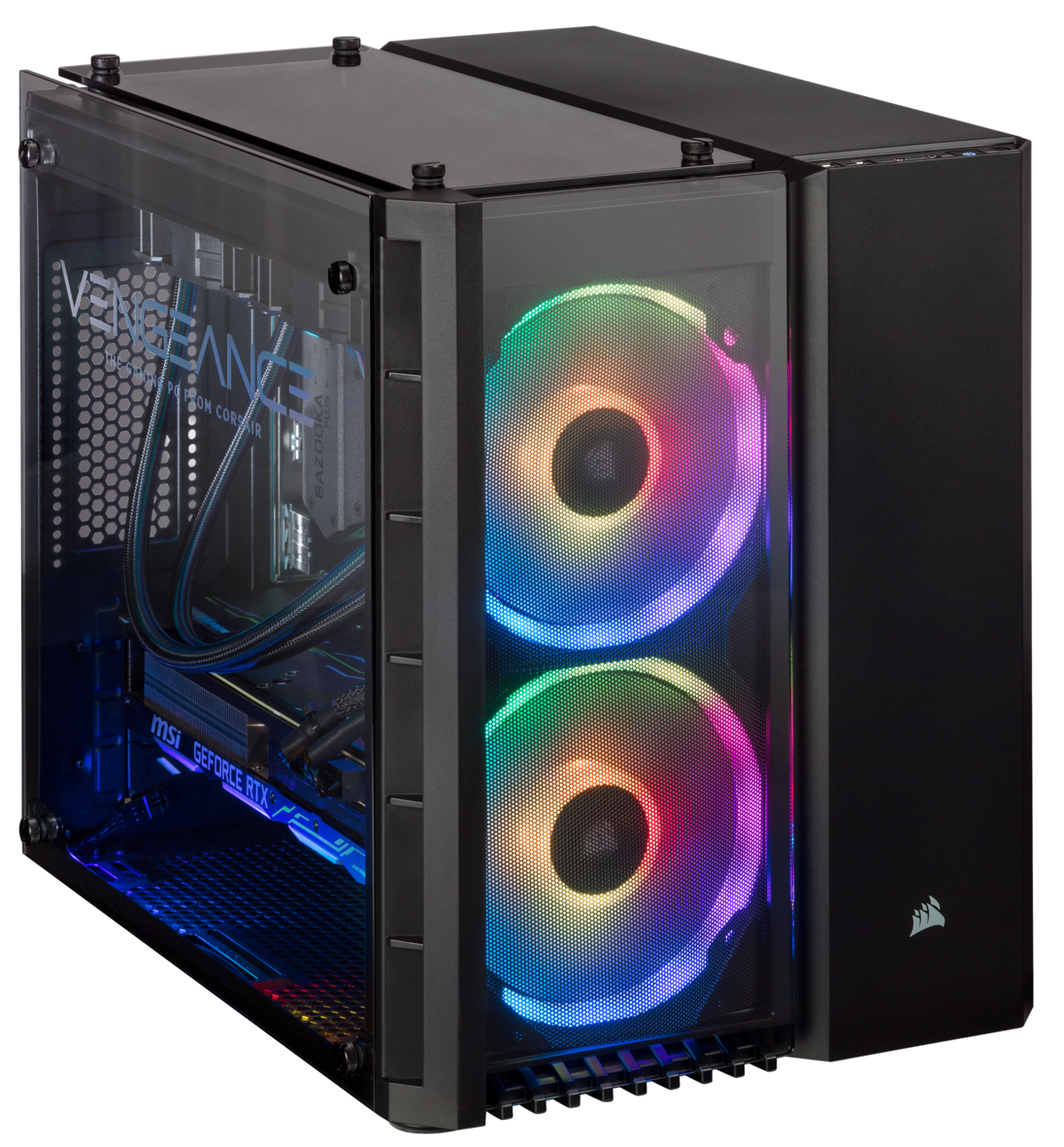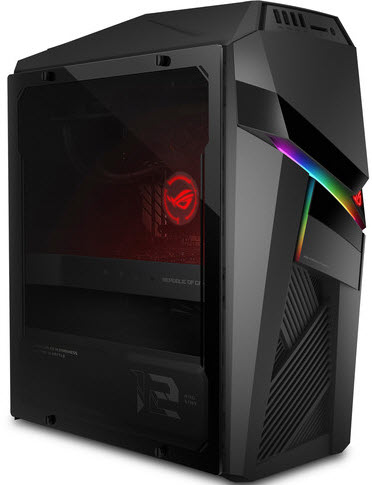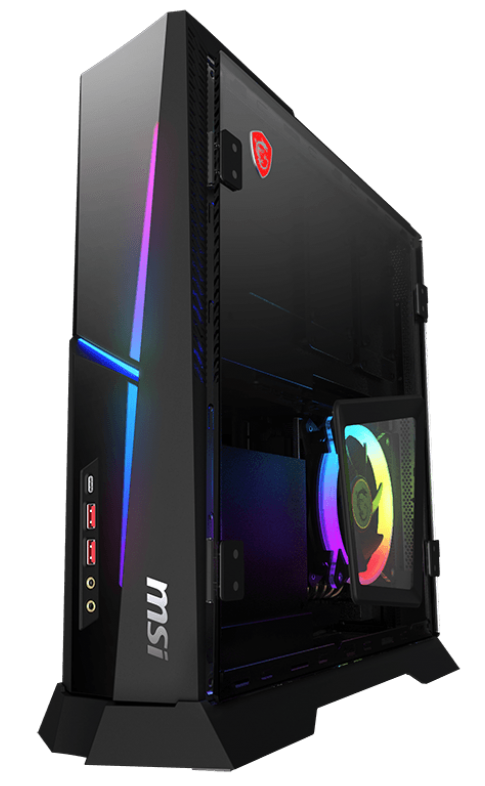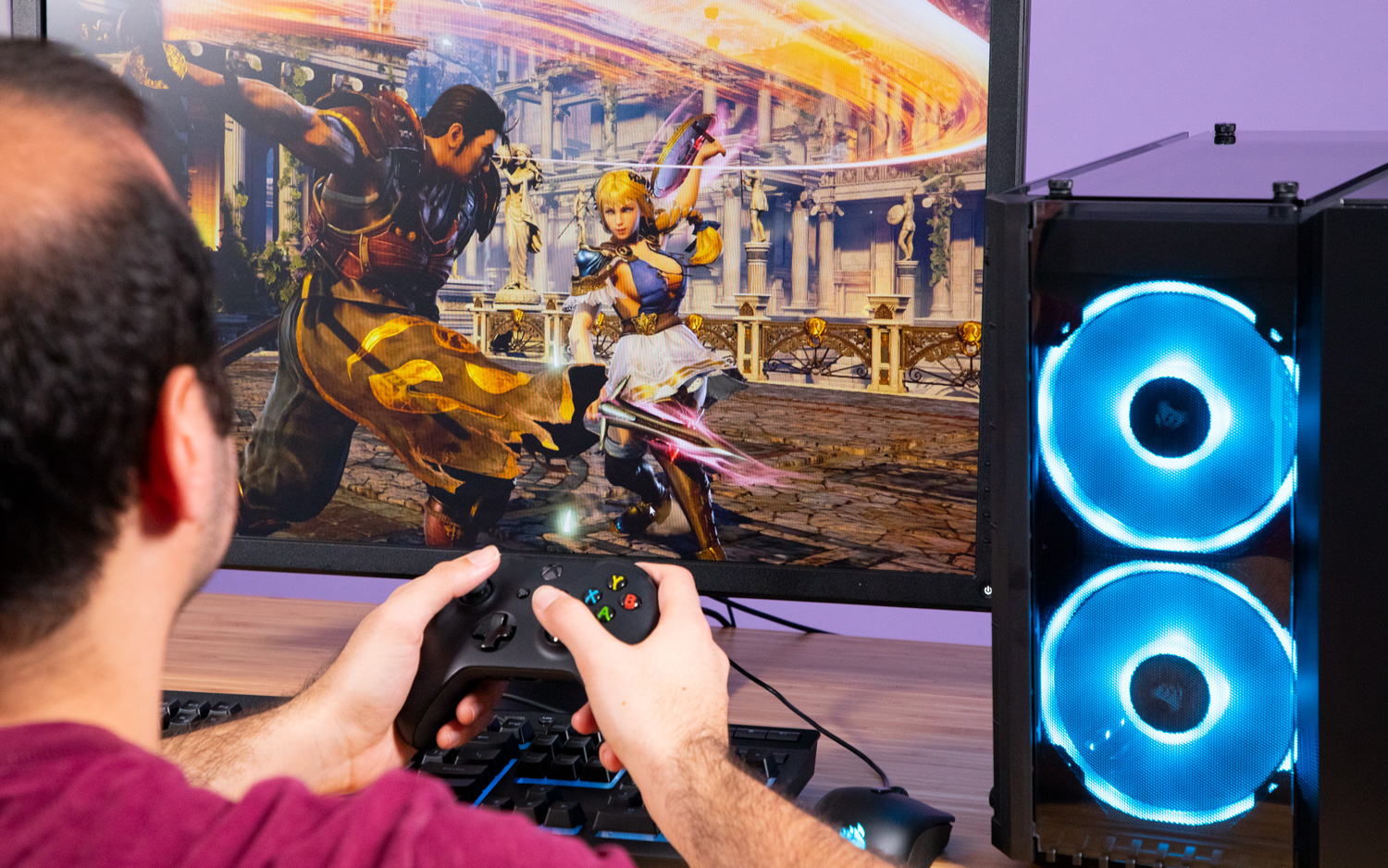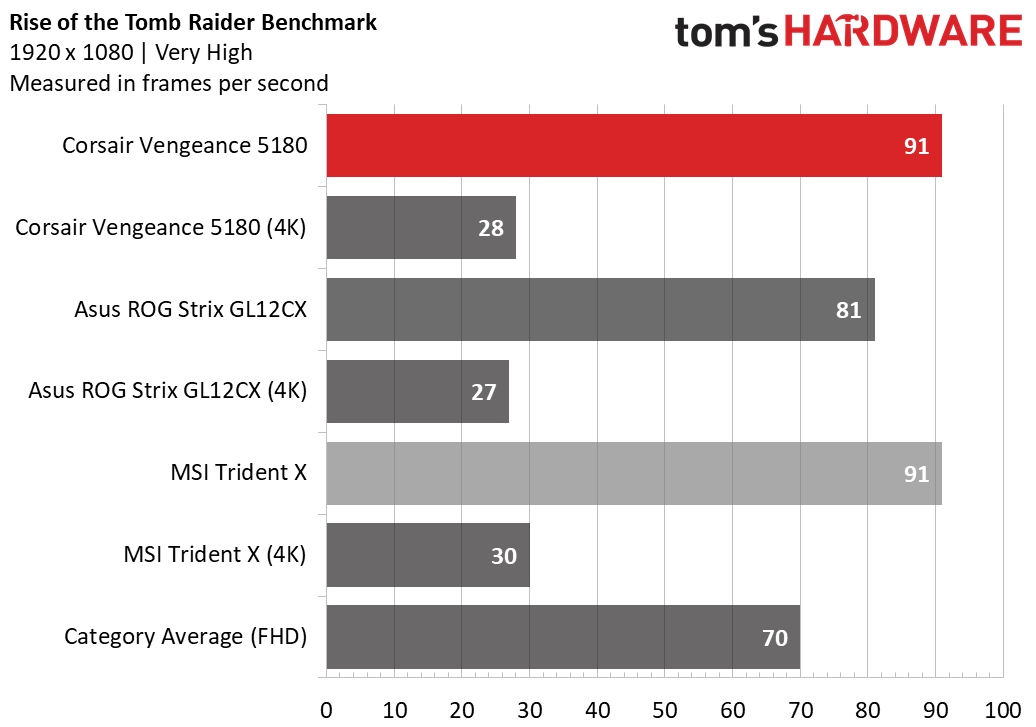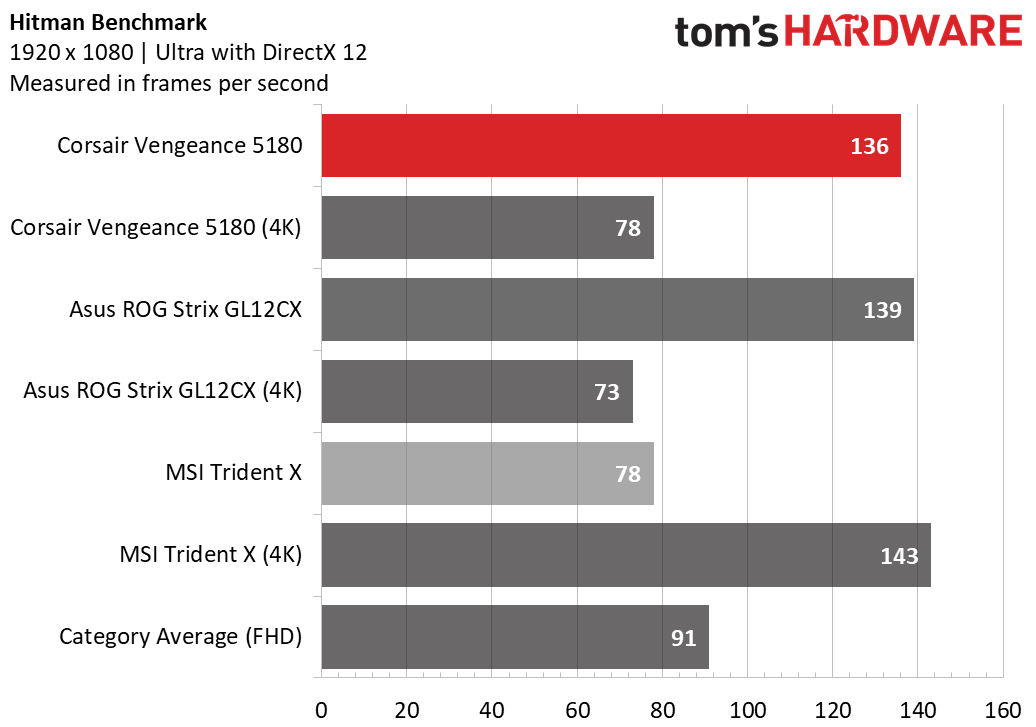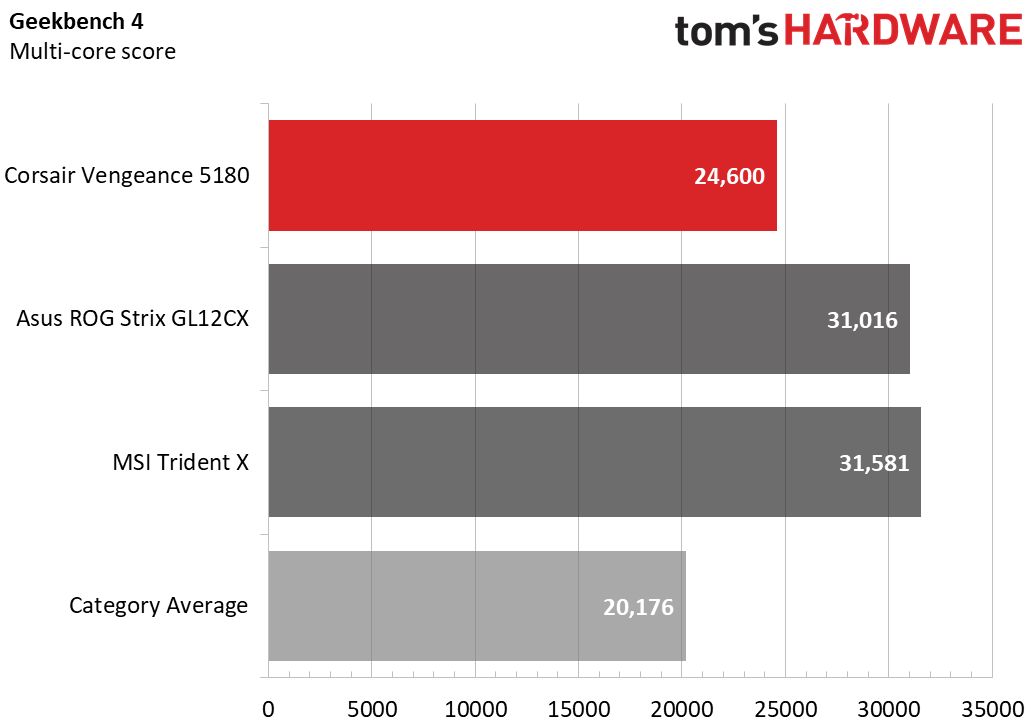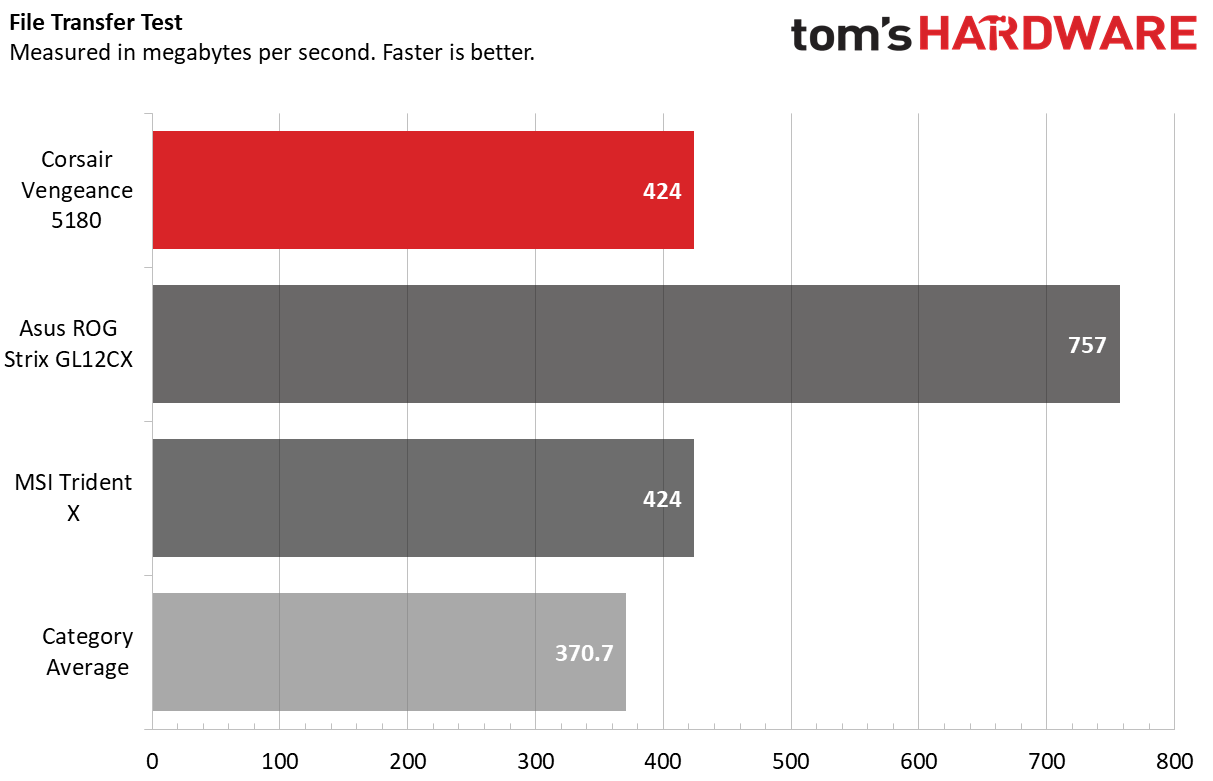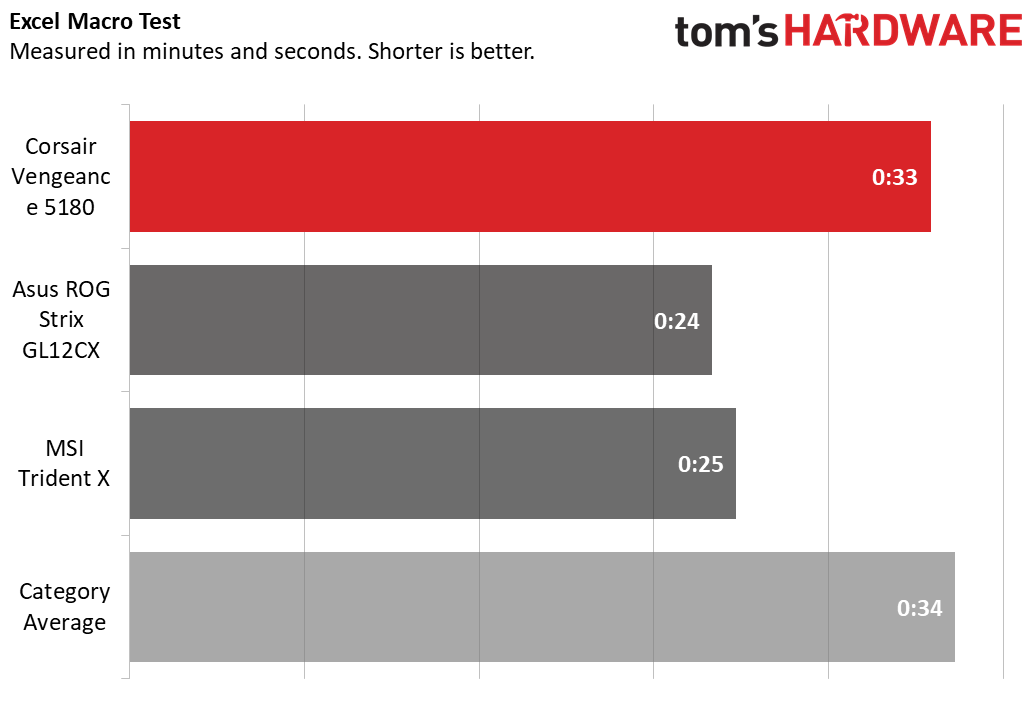Tom's Hardware Verdict
The Corsair Vengeance 5180 Gaming PC is a beautiful Micro-ATX machine that’s easy to upgrade but has a last-gen processor that isn’t as powerful as we would like.
Pros
- +
Beautiful case
- +
Standardized parts
- +
Strong performance
- +
Two-year warranty
Cons
- -
8th gen Intel processor
- -
Lesser productivity scores than competitors
Why you can trust Tom's Hardware
Corsair makes so many of its own components that it’s surprising it hasn’t stuck them all in a computer before. With the Corsair Vengeance 5180 Gaming PC ($2,399, not available in the UK), it has finally used its own case, SSD, cooler, power supply and LED-lit mouse and keyboard in one PC. All of the parts are completely standard, including an Nvidia GeForce RTX 2080 by MSI, making for a PC you can buy now and easily upgrade on your own down the line. But with an 8th generation Intel Core i7-8700, the CPU is older than what some competitors offer out of the box.
Specifications
| Processor | Intel Core i7-8700 |
| Motherboard | MSI B360M Bazooka Plus (Micro-ATX) |
| Memory | 16GB DDR4 Corsair Vengeance RGB Pro 2666MHz (2x 8GB) |
| Graphics | MSI Ventus Nvidia GeForce RTX 2080 (8GB GDDR6) |
| Storage | 480GB M.2 NVMe SSD 2TB, 3.5-inch, 7,200-rpm SATA HDD |
| Networking | Netgear AC1200 Wi-Fi USB AdapterGigabit Ethernet |
| Ports | 2x USB 3.1 Gen 1 Type-A (front)USB 3.1 Gen 2 Type-AUSB 3.1 Gen 2 Type-C4x USB 2.0Microphone jackHeadphone jackPS/2EthernetVirtualLinkAudio out S/PDIF |
| Video Output | 3x DisplayPortHDMI |
| Power Supply | Corsair CX750 750W 80 Plus Bronze |
| Case | Crystal Series 280X RGB (Micro-ATX) |
| Cooling | Hydro H100i Liquid Cooler with 240mm radiator, 2x 140mm fans |
| Operating System | Windows 10 Home |
| Extras | Corsair iCue RGB lighting |
| Dimensions | 15.7 x 10.9 x 13.8 inches (398 x 276 x 351 mm) |
| Price As Configured | $2,399 (not available in UK) |
Design
With a set of parts you can almost completely buy off the shelf, Corsair has put together a beautiful gaming desktop out of black plastic, metal and some tempered glass. The case is the company’s own Micro-ATX Crystal Series 280X RGB. It’s a dual-chamber design with glass on one side and plastic and aluminum on the other.
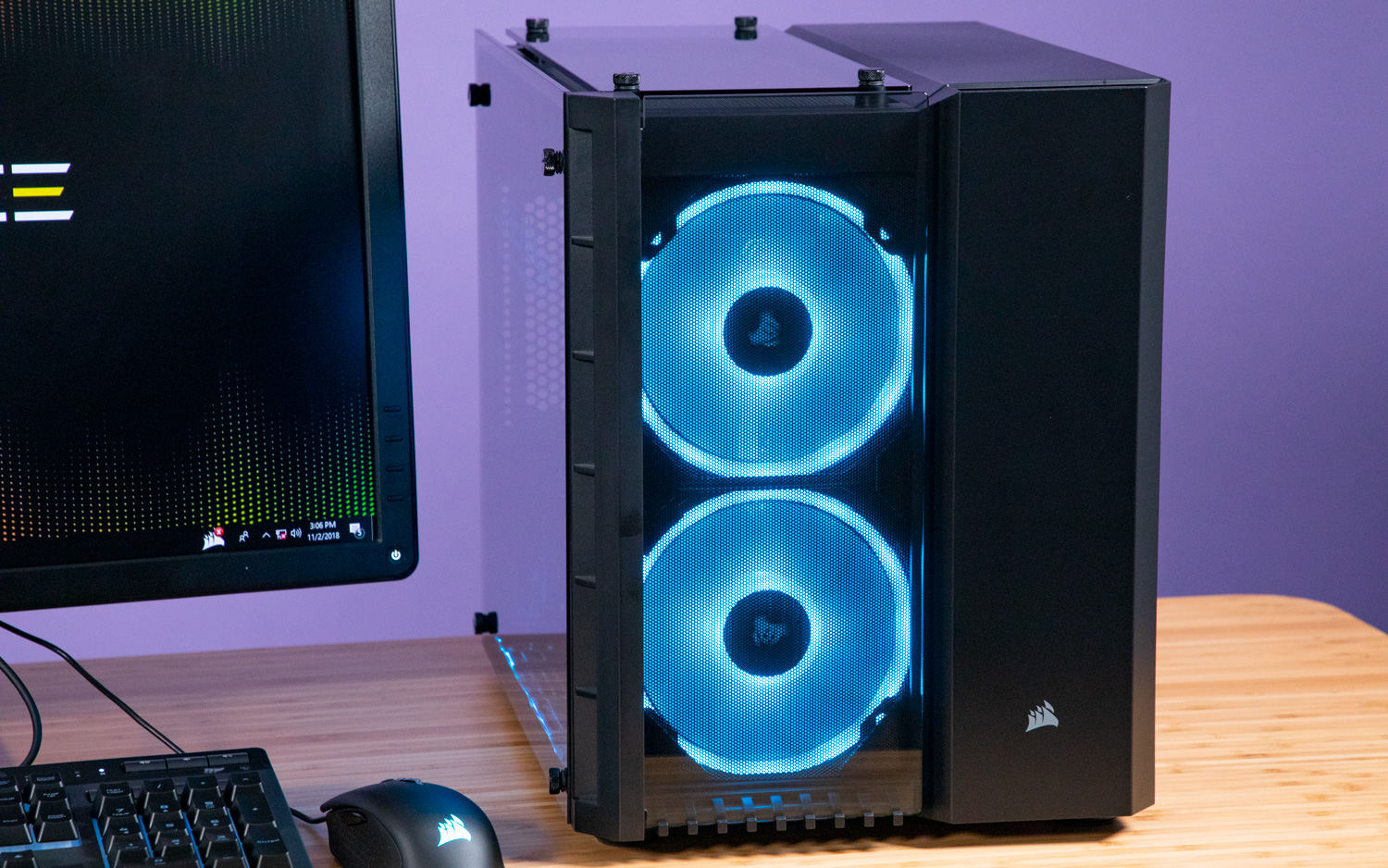
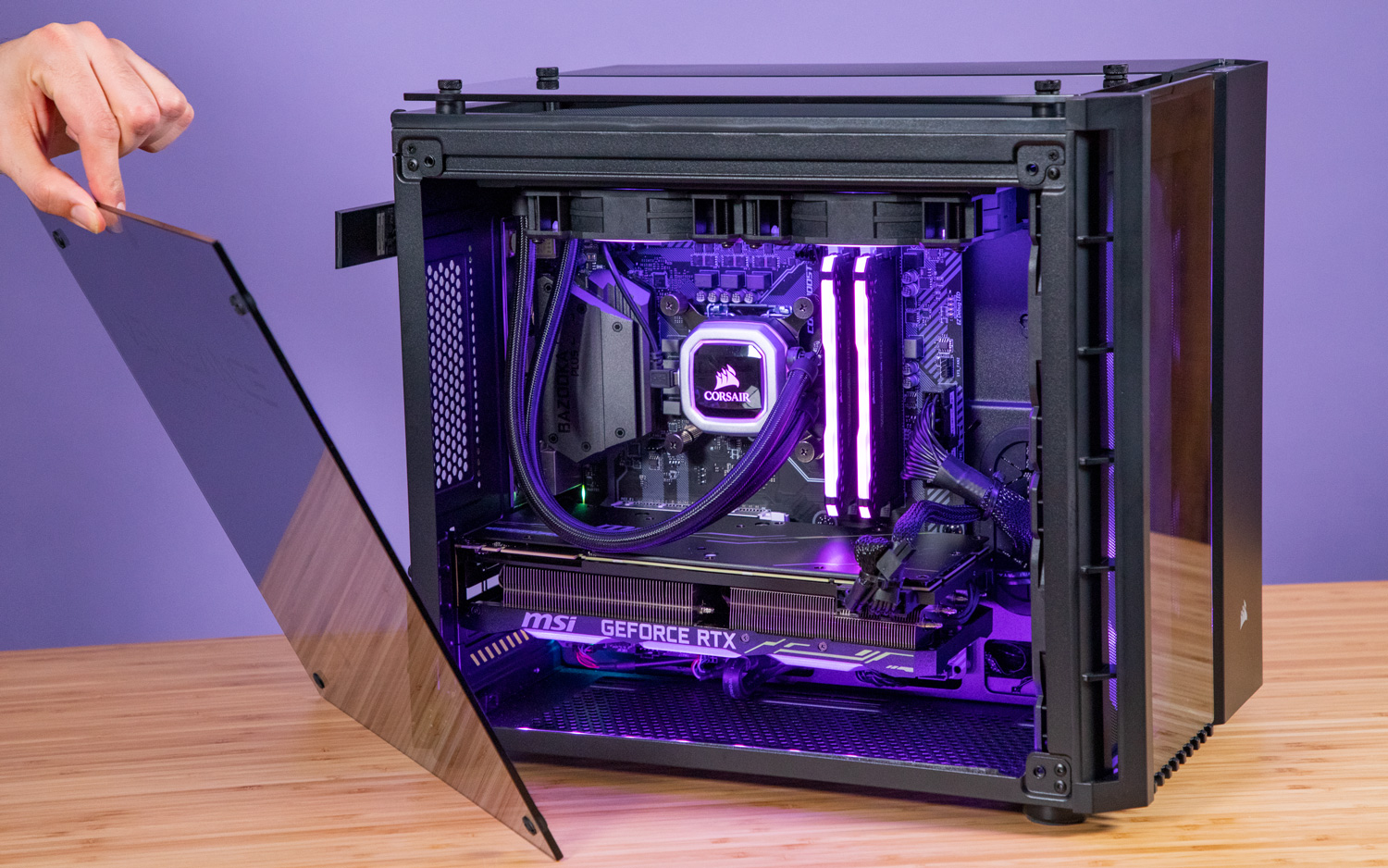
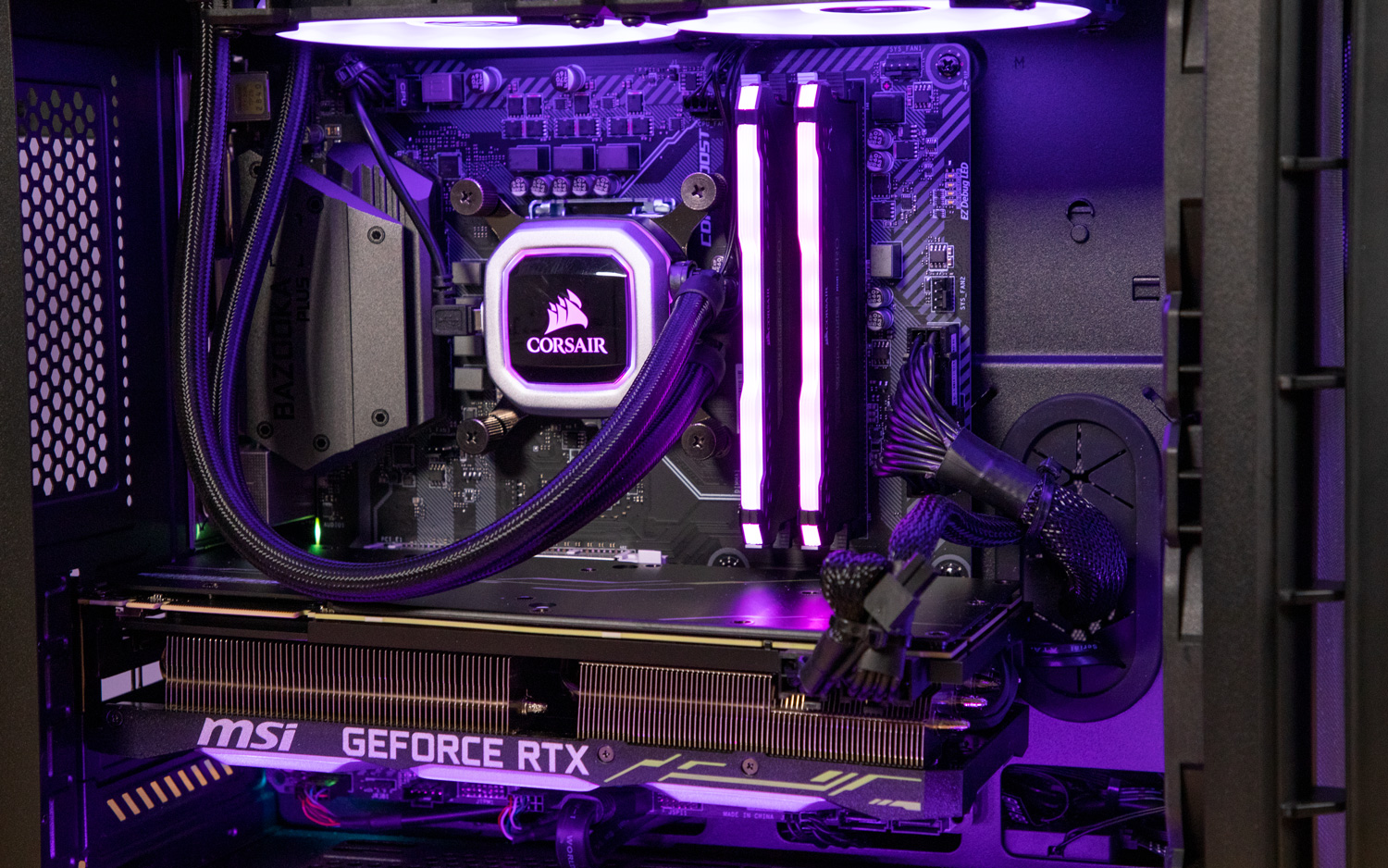
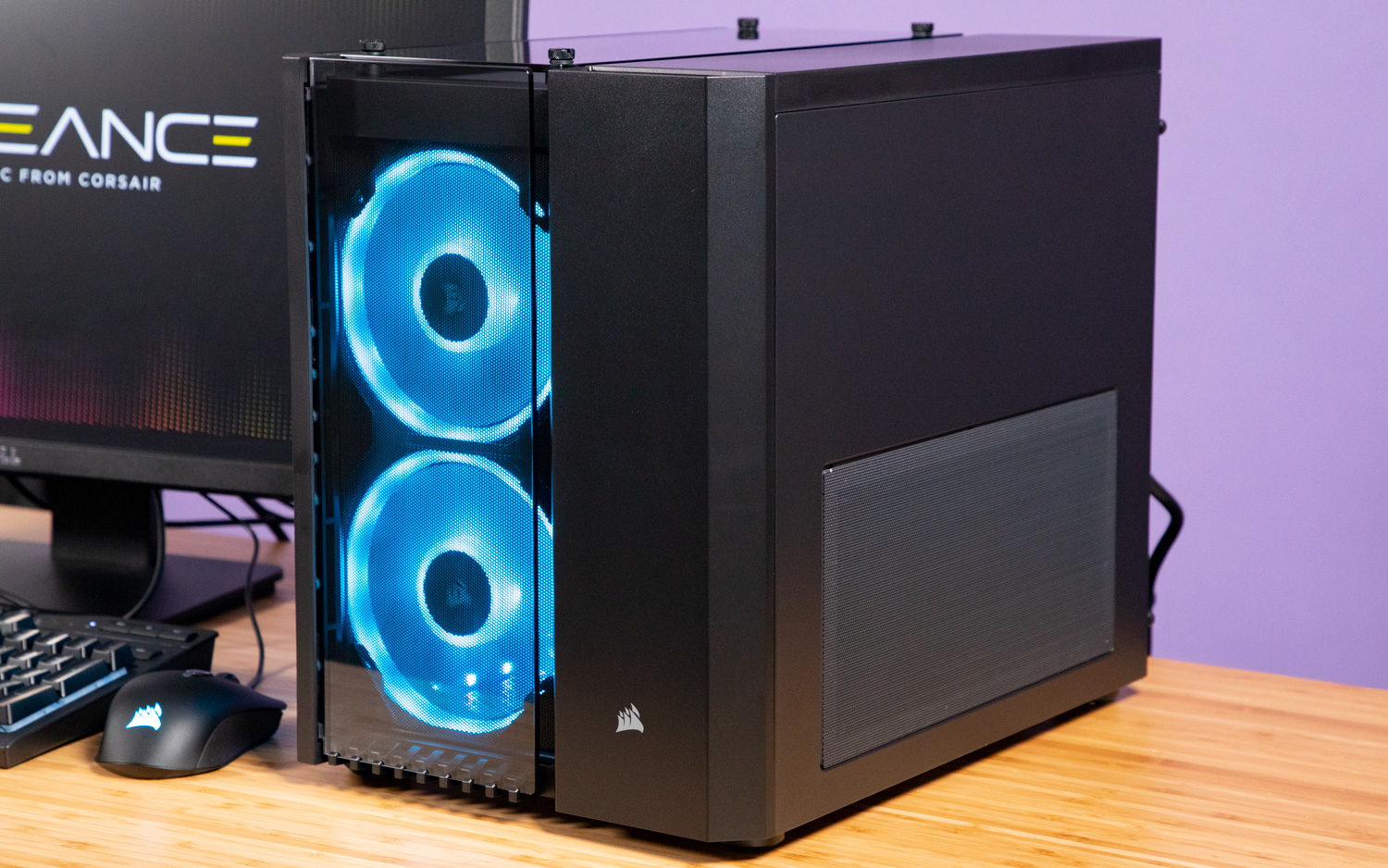
The glass side shows off the majority of the internals, including the motherboard, GPU, RAM and closed-loop CPU cooler with RGB-lit 120mm fans. The front features two RGB-lit 140mm fans. Basically, it’s one big RGB party, and there’s even an additional light strip inside to add a bit more color. The all-black side hides the cable management and storage drives.
The main glass panel reads "VENGEANCE" with the subtitle “The gaming PC from Corsair.” It’s the major difference you’ll notice between this pre-built system and the case on its own.
At 15.7 x 10.9 x 13.8 inches (398 x 276 x 351 mm), the Vengeance is far more sleek than mid-tower PCs with similar components. The Asus ROG Strix GL12CX is 18 x 15.7 x 7 inches (457 x 399 x 177.8 mm), and the MSI Trident X is 15.6 x 15.1 x 5.1 inches (396.4 x 382.7 x 129.7 mm).
Ports and Upgradability
The Vengeance offers plenty of I/O options. The front has a pair of USB 3.1 Gen 1 Type-A ports and headphone and microphone jacks. The MSI motherboard features four USB 2.0 ports, one USB 3.1 Gen 2 Type-A port and one USB 3.1 Gen 2 Type-C. The GPU offers three DisplayPorts, one HDMI and VirtualLink over USB Type-C.
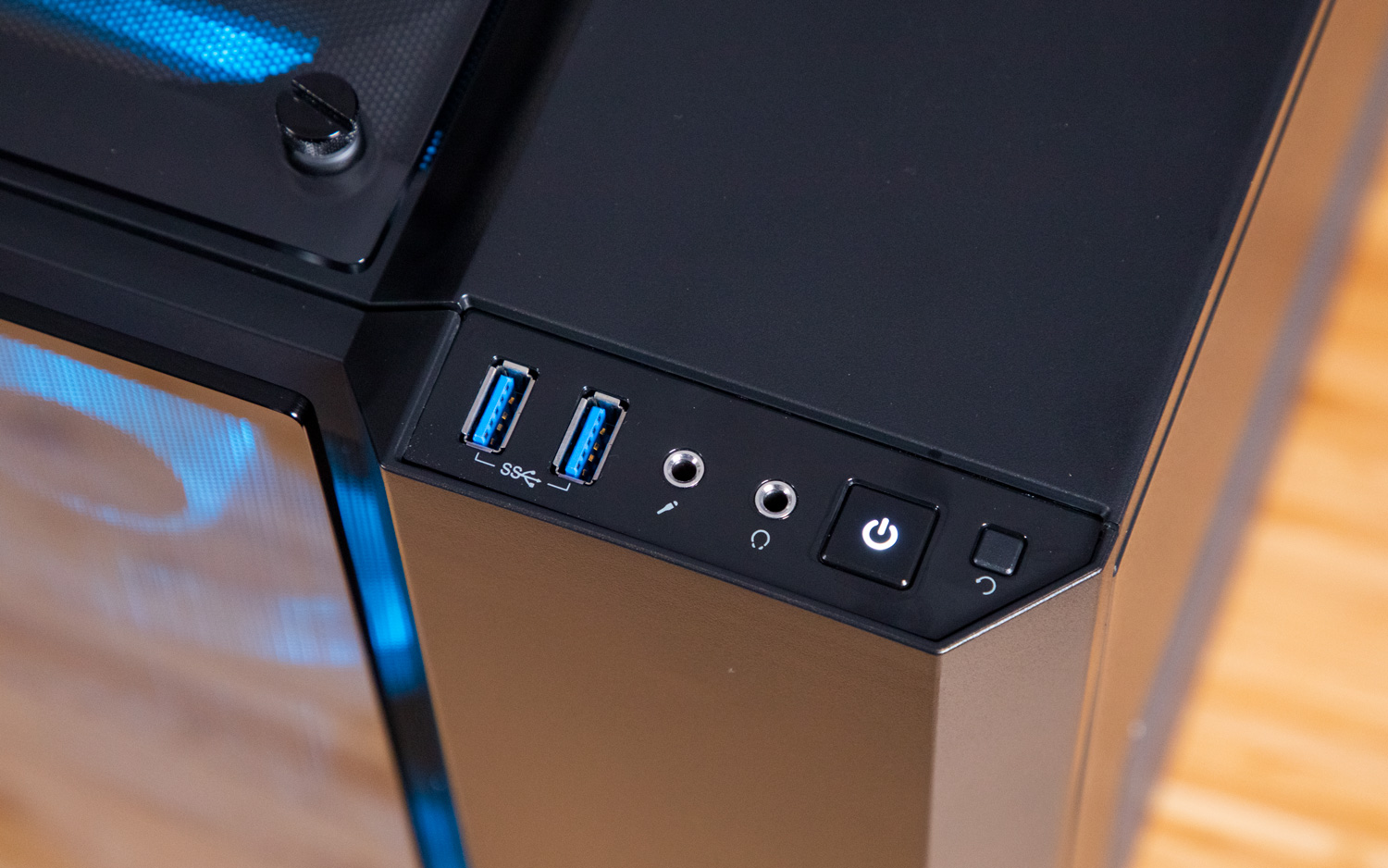
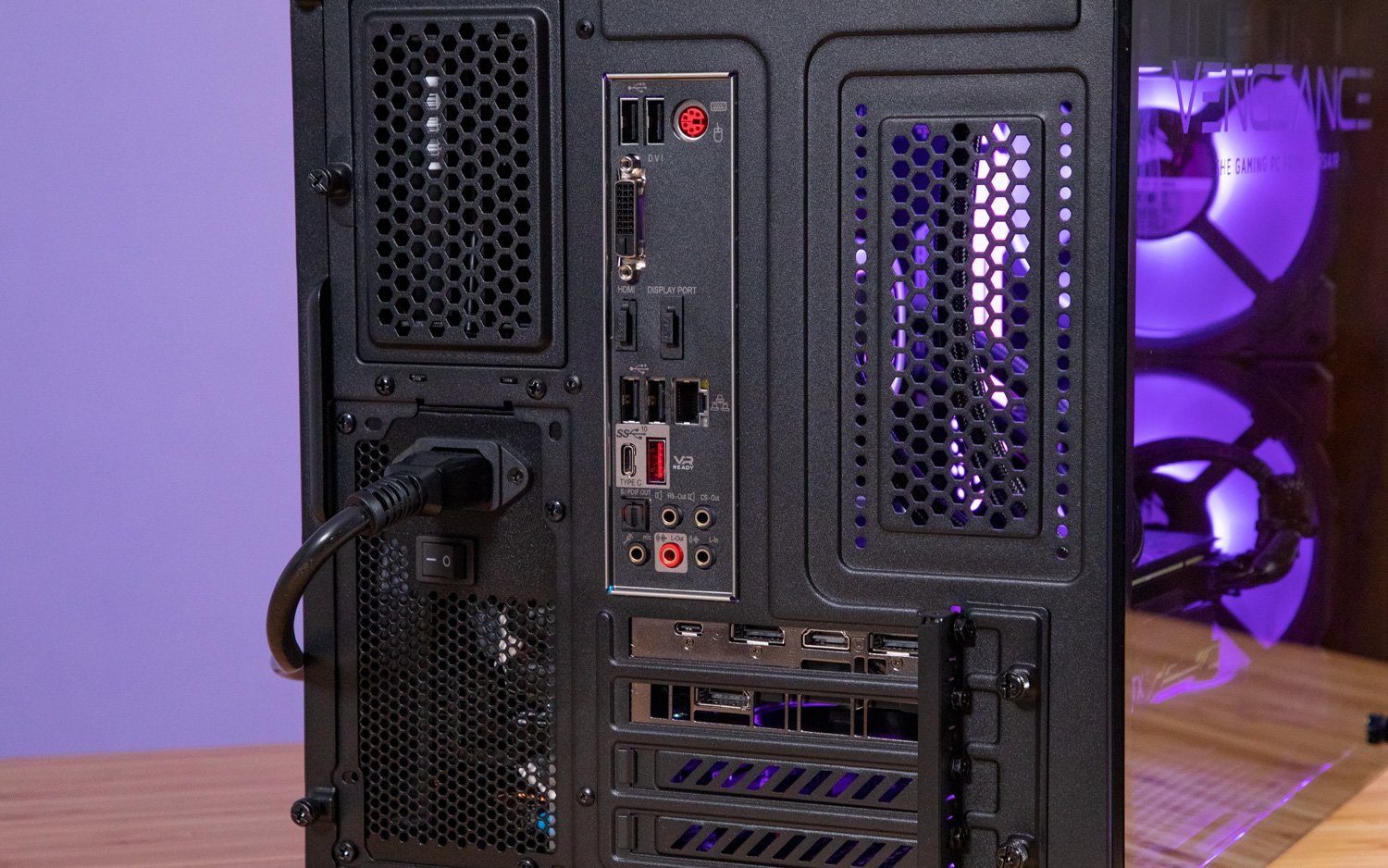
Because this machine doesn’t use custom parts, it’s one of the most upgradable pre-built systems we’ve ever seen. And you don’t need any tools either. All of the screws are hand screws, and while some are pretty tight, I managed to get them out with just my fingers. Most of the components are beneath the tempered glass, while the storage and power supply are in the opaque chamber.
Get Tom's Hardware's best news and in-depth reviews, straight to your inbox.
Gaming, Graphics and VR
The Vengeance comes armed with MSI’s Vestus version of the Nvidia GeForce RTX 2080, packed with 8GB of VRAM. When I played Blackout mode in Call of Duty: Black Ops 4 at 4K resolution with all of the graphics settings maxed out, it ran between 48 and 61 frames per second (fps) with occasional stuttering as I fought my way out of the Hydro Dam. When I knocked it down to 1080p resolution (FHD), the game played between 141 and 165 fps, with one unexpected drop to 108 fps.
On the Rise of the Tomb Raider benchmark, the Vengeance reached 91 fps at 1920 x 1080 on very high settings but only 28 fps at 4K. The FHD desktop average is 70, while at 4K its a higher 37. On both versions the Vengeance was faster than the GL12CX, but it was a touch slower than the Trident X when it came to 4K. The GL12CX and Trident X also use RTX 2080 GPUs.
Grand Theft Auto V proved playable at 4K (very high settings) at 33 fps, again beating the GL12CX but falling below the Trident. At 1080p, it ran at 101 fps, one frame behind Asus’ desktop and three behind MSI’s. All three ran above the 76-fps average.
Corsair’s PC ran Hitman (1920x1080, ultra settings) at 136 fps, falling ever so slightly behind its two competitors (but still above average). At 4K, it ran at 78 fps, tying the Trident and edging out the Strix.
Like the GL12CX and the Trident X, the Vengeance earned a perfect score of 11 on the SteamVR performance test. The gaming desktop average is 9.6.
On our stress test, in which we run Metro: Last Light 10 times in a row, it achieved an average frame rate of 107.7 fps. It started with a first run average of 104 fps, finding a baseline around 110 fps for most of the subsequent runs and returning to 104 fps for the final run. The CPU ran at an average of 4.2 GHz and 57.4 degrees Celsius (135.3 degrees Fahrenheit). The GPU ran at an average clock speed of 1.8 GHz and 67.8 degrees Celsius (154 degrees Fahrenheit).
Performance
With a liquid-cooled Intel Core i7-8700, 16GB of RAM, a 480GB M.2 NVMe SSD and 2TB, 3.5-inch, 7,200-rpm SATA HDD, the Corsair Vengeance is more than enough for simple workloads, like web browsing, word processing and even some photo editing. But competitors use more powerful 9th generation Core Intel CPUs, so the Vengeance had a rocky time with our performance benchmarks in comparison.
On Geekbench 4, it earned a score of 24,600. While that’s higher than the gaming desktop average of 20,176, it’s far lower than both the GL12CX and Trident X, which both have Intel Core i9-9900K CPUs.
The Vengeance took 12 seconds to copy 4.97GB of files, which translates to 424MBps. That ties the Trident X but surpasses the average of 370.7MBps. The GL12CX, at a blazing 757MBps, was quicker.
On our Excel macro test, the Vengeance paired 65,000 names in 33 seconds. That’s one second ahead of the 34-second average, but slower than both the GL12CX and the Trident.
It took 9 minutes and 7 seconds for the Vengeance to complete our Handbrake test, which transcodes 4K video to 1080p. The Vengeance and Trident X were both far faster with 9th gen CPUs.
Keyboard and Mouse
Just like many of the Vengeance’s parts, the keyboard and mouse that come with it are made and sold separately by Corsair. Specifically, there's the Harpoon RGB Mouse ($29.99 / £27.99) and K55 RGB keyboard ($49.99 / £54.99).
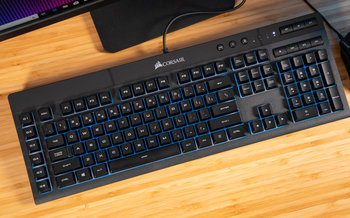
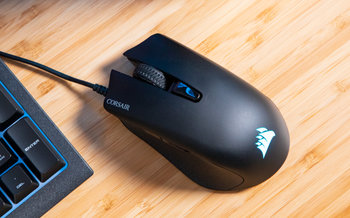
Neither of these are amazing, but they’re still better than the average pack-in. The mouse has rubbery grips, four buttons, a click wheel and another button just for adjusting DPI. The keyboard has membrane rubber dome switches, dedicated media keys and six customizable macro buttons. Both peripherals support RGB lighting through Corsair’s iCue software.
Software and Warranty
Corsair’s software load is quite sparse. Our review unit came with iCue for managing the copious amount of RGB hardware included and Corsair Diagnostics, which runs system scans.
However, you still get all of the bloat that comes with every build of Windows 10, like Hidden City: Hidden Object Adventure, Drawboard PDF and not one but two different versions of Candy Crush.
Corsair sells the Vengeance 5180 Gaming PC with a two-year warranty.
Buy or Build?
The only configuration of the Vengeance is the $2,399 unit I’m reviewing here. But I had one curiosity about the machine I couldn’t shake: since all of these pieces are standard, not proprietary, would it be cheaper just to build the PC?
Component prices are constantly shifting, but while reviewing the Vengeance, I put together a parts list in PCPartPicker and came up with a base total of $2,164.74 (that includes a $95 Windows license, which, as we know, can be found for lesser prices). It also includes the keyboard, mouse and USB Wi-Fi adapter.
So it is, indeed, slightly cheaper to build, but those who want someone else to put it together aren’t paying a massive premium to have it assembled for them.
Bottom Line
If you’re looking for a premium gaming desktop, the Corsair Vengeance is a strong option. While its GPU offers powerful gaming performance now, the standardized parts make it easy to upgrade whenever you want. No weird custom motherboards here.
There are a few cases, however, where the MSI Trident X wins. For $100 more, you can get a Core i9-9900K, which beats the Corsair's last-gen Intel Core i7-8700. That makes the MSI a better deal for the money. MSI also offers a mid-tower size case if you prefer something that size. However, while the MSI also offers standardized parts, it has a harder chassis to work in than the Corsair.
But if you want a pre-built system that you can eventually make your own, all backed by a two-year warranty and plenty of RGB, the Vengeance is all you need. It’s just not the best value out there.
MORE: Best Gaming Desktops
MORE: How To Build A PC
MORE: All PC Builds Content
Photo Credit: Tom's Hardware

Andrew E. Freedman is a senior editor at Tom's Hardware focusing on laptops, desktops and gaming. He also keeps up with the latest news. A lover of all things gaming and tech, his previous work has shown up in Tom's Guide, Laptop Mag, Kotaku, PCMag and Complex, among others. Follow him on Threads @FreedmanAE and BlueSky @andrewfreedman.net. You can send him tips on Signal: andrewfreedman.01
-
jimmysmitty The only change I would make to the system myself is the PSU. The CX series isn't horrible but I would prefer a gold or better rated PSU. However its still a nice prebuilt and I would probably recommend it over a lot of the other companies. Especially iBuy or Cyberpower.Reply -
2Be_or_Not2Be Corsair - I hope you're listening.Reply
At the price this system is starting out at & the fact the CPU is an older 8th gen, I would definitely buy the Trident over it.
Reduce the price for your initial foray into complete gaming PCs. Rather ironic considering you've got some good value-priced items in PSUs, RAM, etc. -
IceMyth Sorry but this build does not worth it for many reasons (I mean this device):Reply
1- The CPU is none OC (Not K) + what other said Old gen.
2- The cooler for none OC cpu is waste of money (120mm or even air cool is enough)
3- The PSU is sub-bar and it is bronze.
Building a PC by your self is away better and cheaper.
